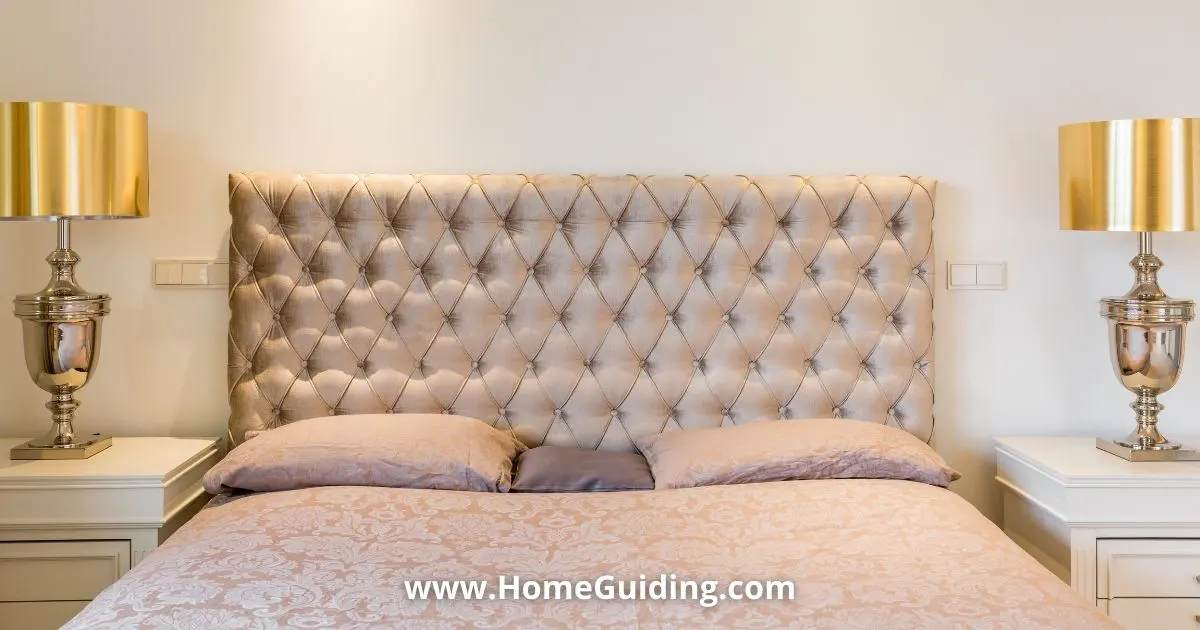When it comes to bedroom furniture, the headboard is often an essential piece that many homeowners want to incorporate into their decor.
However, not all beds come with a headboard, and some people may wonder if it’s possible to fit a headboard to any bed.
Can You Fit a Headboard to Any Bed?
While it is true that headboards can be attached to many bed frames, it is not accurate to say that they can be attached to any bed frame. The compatibility of a headboard with a bed frame depends on factors such as the size and design of both the headboard and the bed frame. It is important to check the specifications of both before attempting to attach a headboard.
- Firstly, the size of the bed and the headboard need to match.
- A queen-sized headboard won’t fit on a twin bed, for example.
- Additionally, the headboard needs to be compatible with the bed frame.
Some headboards are designed to attach directly to the bed frame, while others may require additional hardware or modifications to fit properly.
With these considerations in mind, it’s possible to fit a headboard to almost any bed, allowing homeowners to add a stylish and functional piece to their bedroom decor.
Bed Types:
When it comes to fitting a headboard to a bed, the type of bed frame you have is an important factor to consider.
Here are some common bed types and how they can affect headboard compatibility.
Standard Bed Frames:
Standard bed frames are the most common type of bed frame and are typically made of metal or wood.
These frames have a headboard and footboard that are attached directly to the frame.
Most headboards are designed to fit standard bed frames, so finding a compatible headboard should not be difficult.
Adjustable Beds:
Adjustable beds are becoming increasingly popular due to their ability to adjust to different positions for maximum comfort.
However, these beds can be a bit trickier when it comes to finding a compatible headboard.
Some adjustable beds come with headboards that are designed specifically for that model, while others require a special bracket to attach a headboard.
Platform Beds:
Platform beds are becoming more popular due to their sleek and modern design.
These beds typically have a low profile and do not require a box spring. However, finding a compatible headboard for a platform bed can be a bit more challenging.
Some platform beds come with a headboard attached, while others require a special bracket to attach a headboard.
Bunk Beds:
Bunk beds are a great space-saving option for kids’ rooms or guest rooms.
However, because of their unique design, finding a compatible headboard can be difficult.
Some bunk beds come with a headboard attached, while others do not have a headboard at all.
In summary, the type of bed frame you have can affect headboard compatibility.
Standard bed frames are the easiest to find compatible headboards for, while adjustable beds, platform beds, and bunk beds may require special brackets or come with a headboard already attached.
Headboard Types:

There are several types of headboards that can be attached to a bed frame.
The three most common types are bolt-on, hook-on, and freestanding headboards.
Bolt-On Headboards:
Bolt-on headboards are attached to the bed frame using bolts.
These headboards have pre-drilled holes that line up with the holes on the bed frame.
The bolts are then inserted through the holes and tightened with nuts. Bolt-on headboards are the most secure type of headboard and are suitable for heavy headboards.
Hook-On Headboards:
Hook-on headboards have hooks on the legs or sides of the headboard that attach to the bed frame.
These headboards are easy to install and remove, making them a good option for those who like to change their decor frequently.
However, hook-on headboards may not be as secure as bolt-on headboards and may wobble or move.
Freestanding Headboards:
Freestanding headboards do not attach to the bed frame and can be placed behind the bed.
These headboards are usually heavy and have legs that keep them upright.
Freestanding headboards are a good option for those who want a headboard but do not want to attach it to the bed frame.
However, freestanding headboards may not be as secure as bolt-on or hook-on headboards and may move or topple over.
Overall, the type of headboard that is suitable for a bed depends on the bed frame and personal preference.
It is important to choose a headboard that is secure and fits the style of the room.
Is it necessary to have a headboard?
Having a headboard is not a necessity for a bed, but it can provide several benefits that make it a worthwhile addition to your bedroom.
Here are some reasons why you might consider having a headboard:
- Comfort: A headboard provides a comfortable backrest for sitting up in bed to read, watch TV, or work on a laptop. It can also prevent your pillows from slipping down between the bed and the wall, which can be uncomfortable and frustrating.
- Style: A headboard can enhance the overall style and aesthetic of your bedroom. It can serve as a focal point and add visual interest to the room. There are countless headboard styles to choose from, ranging from traditional to modern, so you can find one that fits your personal style.
- Protection: A headboard can protect your wall from damage caused by the bed frame rubbing against it. This is especially important if you have a wall with delicate wallpaper or paint that could be easily damaged.
- Insulation: A headboard can provide insulation and keep you warmer in the winter by creating a barrier between you and the cold wall.
- Noise reduction: A headboard can help reduce noise by absorbing sound and preventing it from bouncing off the wall.
How Can You Fit a Headboard to Any Bed?
Headboard installation is a relatively straightforward process that can be done in just a few steps.
To fit any bed with a headboard, you will need the following materials:
- Headboard
- Bed frame and mattress
- Screws or bolts (depending on the type of headboard)
- Drill or screwdriver Once you have all your materials ready, here’s how to go about fitting it to your bed:
- Assemble and attach the bed frame to your mattress according to instruction manual instructions if needed. Make sure that all screws are tightened securely before moving onto step 2.
- Place the headboard against the wall at an angle so that it is flush with both sides of the bedframe and mark where each screw hole should go on both walls for later reference when attaching them permanently with screws/bolts respectively.
- 3 Line up each marked area from Step 2 with its respective predrilled holes in the head board then use either drill or screwdriver depending on which hardware was included in package.Depending on what type of hardware you are using , make sure to tighten down firmly but not too tight as this could cause damage!
- Lastly, enjoy your new stylish addition!
How do you attach a headboard to an existing bed?
Here are the general steps to attach a headboard to an existing bed frame:
- Check the compatibility: Ensure that the headboard is compatible with your bed frame, both in terms of size and design.
- Gather the necessary tools: You will need bolts, screws, washers, and a wrench or screwdriver to attach the headboard to the bed frame.
- Position the headboard: Place the headboard in the desired location behind the bed frame. Make sure it is centered and level.
- Mark the holes: Using a pencil or marker, mark the locations on the bed frame where the headboard will be attached. Make sure to mark both sides of the bed frame.
- Drill holes: Using a drill, make pilot holes in the marked locations on the bed frame. This will help to prevent the wood from splitting when you attach the headboard.
- Attach the brackets: With the help of a friend, hold the headboard up against the bed frame and attach the brackets to the bed frame using bolts, screws, and washers. Make sure the brackets are securely fastened to the bed frame.
- Secure the headboard: Once the brackets are attached, carefully lower the headboard onto the brackets and secure it in place using bolts, screws, and washers. Tighten the bolts and screws until the headboard is firmly attached to the bed frame.
- Check for stability: Test the headboard for stability by gently pushing on it from different angles. If it feels loose, tighten the bolts and screws until it feels secure.
- Enjoy your new headboard: Once the headboard is securely attached, make your bed and enjoy your new headboard!
Does a headboard need to be attached to the bed?
A headboard does not necessarily need to be attached to the bed.
But it is recommended for several reasons:
- Stability: Attaching the headboard to the bed frame provides stability and prevents it from shifting or falling over. This is especially important if you have a heavier or larger headboard.
- Safety: A headboard that is not attached to the bed frame can be a safety hazard, as it may fall over or shift unexpectedly. This can be dangerous, especially if you have children or pets in the room.
- Comfort: A headboard that is attached to the bed frame provides a more comfortable sleeping experience, as it prevents your pillows from slipping down between the bed and the wall.
- Style: Attaching the headboard to the bed frame can enhance the overall style and aesthetic of your bedroom. It creates a cohesive look and can make the bed look more polished and put-together.
In summary, while a headboard does not necessarily need to be attached to the bed, it is recommended for stability, safety, comfort, and style reasons.
Advantages and Disadvantages of Fitting A Headboard to Your Bed:
A headboard is a great way to personalize your bedroom.
It can provide both aesthetic and functional benefits, such as providing extra support for bed pillows when reading in bed, or simply adding a decorative element to the look of the room.
But with any purchase, there are advantages and disadvantages to consider before investing in a headboard for your bed:
Advantages of Fitting A Headboard to Your Bed:
- Adds visual appeal and style to your bedroom
- Can customize the size and design according to your preferences
- Offers additional back support while sitting up in bed
- Easy installation (in most cases)
Disadvantages of Fitting A Headboard To Your Bed:
- May require professional help if it’s not an easy DIY project
- Can be expensive depending on materials used
- May limit space in smaller bedrooms
Conclusion:
In conclusion, while it is possible to fit a headboard to many bed frames, it is not accurate to say that it can be attached to any bed frame.
The compatibility of a headboard with a bed frame depends on several factors, such as the size and design of both the headboard and the bed frame.
It is important to check the specifications of both before attempting to attach a headboard.
Additionally, while a headboard is not a necessity for a bed, it can provide several benefits, including comfort, style, protection, insulation, and noise reduction.
Ultimately, the decision to have a headboard comes down to personal preference and the specific needs of your bedroom.

